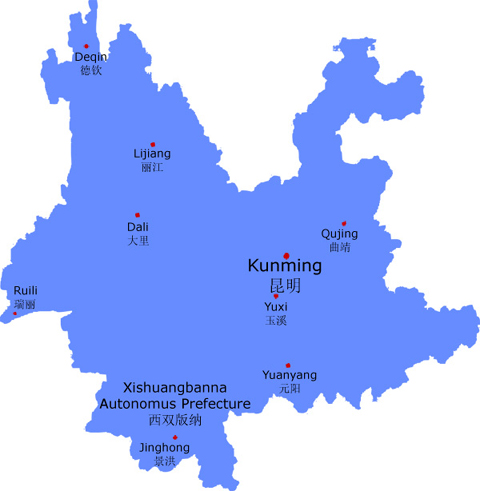Kunming SightseeingKunming serves not only as the provincial center of Yunnan but also as the destination for its flourishing tourism with so many places of interest spread all around the city.
The Stone Forest is in Lunan Yi Nationality Autonomous County, which is about 120 kilometers (75 miles) from Kunming and requires only a three-hour drive. It covers an area of 400 square kilometers (96,000 acres) and includes both large and small stone forests, as well as many other scenic spots. An old local saying says that 'If you have visited Kunming without seeing the Stone Forest, you have wasted your time.' Truly, the Stone Forest is one of the most important attractions of Yunnan. Geologists say the Stone Forest is a typical example of karsts topography. Approximately 270 million years ago - during the carboniferous period of the Paleozoic era - the region was a vast expanse of sea. Over time, the movements of the lithosphere gradually caused a retreat of the waters and the rise of the limestone landscape. Due to constant erosion by the elements, the area finally developed into the present-day Stone Forest. These magnificent stone masterpieces make Stone Forest worthy of the fame as the 'First Wonder of the World'. The landscape creates countless labyrinthine vistas, including:
 Dianchi Lake is about 300 square kilometers (74,132 acres).
It is the largest freshwater lake in Yunnan Province and the
sixth largest one in China. It is a favorite with those who want
to escape from the hustle and bustle of the city life. With
picturesque scenery and its location on the Yungui Plateau, the
lake has a reputation as 'A Pearl on the Plateau'.
Dianchi Lake is about 300 square kilometers (74,132 acres).
It is the largest freshwater lake in Yunnan Province and the
sixth largest one in China. It is a favorite with those who want
to escape from the hustle and bustle of the city life. With
picturesque scenery and its location on the Yungui Plateau, the
lake has a reputation as 'A Pearl on the Plateau'. The lake is crescent-shaped, about 39 kilometers (24 miles) in length and 13 kilometers (8 miles) in width at it's widest. Its natural banks are formed by mountains on all four sides. More than twenty rivers nurture the lake which has a shoreline of 163.2 kilometers (101 miles). Four surrounding hills contribute to the picturesque landscape. Lots of tourists choose to appreciate the beauty of the lake and hills from a boat, and explore this cradle of Yunnan culture.
 The Dianchi Lake Scenic Area is located in the southwest part of
Kunming City. Dianchi Lake is, beyond question, the center
of the resort. However, there are numerous attractions along
the lake captivating tourists. Among these are the Yunnan Ethnic
Villages, Daguan Park, Baiyukou Park, Haigeng Bank, Kwan-yin
Hill, Xishan Forest Park, temples and pagodas. Towns, big or
small near the lake provide visitors with an opportunity to
experience customs of the local people.
The Dianchi Lake Scenic Area is located in the southwest part of
Kunming City. Dianchi Lake is, beyond question, the center
of the resort. However, there are numerous attractions along
the lake captivating tourists. Among these are the Yunnan Ethnic
Villages, Daguan Park, Baiyukou Park, Haigeng Bank, Kwan-yin
Hill, Xishan Forest Park, temples and pagodas. Towns, big or
small near the lake provide visitors with an opportunity to
experience customs of the local people.
These villages act as a good shortcut to understand the social customs of the ethnic groups in Yunnan. Twenty-six Chinese ethnic minority groups have their respective villages and conduct many activities to present their unique folkways and beautiful clothes.
Baiyukou Park is on the west bank of Dianchi Lake. Here a small hill looks like a white fish opening its mouth to Dianchi Lake. Near the Irregular shore line, beautiful gardens are hidden among green trees. In spring, the cherry trees are in blossom, adding luster to this serene place. Overlooking Dianchi Lake, there are white sails of boats can be seen on the glistening lake and gulls skimming over the waves.
Haigeng Bank is about four kilometers (2.5 miles) long while ranging in width from forty meters (131 feet) to three hundred meters (984 feet). The bank, like a floating jade belt, is in fact a watershed of the Dianchi Lake. Slender willow twigs sweep the lake in the gentle breeze. In the south is a wonderful natural swimming pool which is always crammed with people in midsummer.
Kwanyin Hill is bordered by the vast lake and has an altitude of 2,040 meters (6,693 feet). Lofty peaks on this hill seem to thrust themselves straight towards the sky. A Kwan-yin Temple built here in the Ming Dynasty (1368-1644) was once a popular resort of Buddhism. Remaining are a seven-tier brick pagoda, houses, and a gate to the Kwan-yin Temple.
It is composed of Penfeng Cave, Hongxi Spring and an underground river. From August to November, gales lasting two to three minutes sweep out of the cave every 30 minutes.
This is a karsts lake that is three kilometers (two miles) long but only 300 meters (0.2 miles) wide. The lake features underwater stalagmites and stalactites and a small island in the center of the water. The source of the Dadie Waterfall, Ba River, is a branch of Nanpan River. In the rainy season, up to 150 cubic meters (196 cubic yards) of water per square inch plummet down the 88 meter (288 feet ) drop.
Yuantong Temple is at the foot of Yuantong Hill in the northern part of Kunming. With a history of more than 1,200 years, Yuantong Temple is the grandest as well as the most important Buddhist temple in Yunnan Province. King Yimouxun of the Nanzhao Kingdom built the temple during the late eighth century as a continuation of Putuoluo Temple, and the restorations to the temple performed from the Qing Dynasty onward had not changed Yuantong Temple's unique mixed architectural style of the Yuan and Ming Dynasties. Unlike all other Buddhist temples, which are built on an ascendant, you enter Yuantong Temple from above and descend along a gently sloping garden path. The temple complex is built around Yuantong Hall (Mahavira Hall), which is known as the Fane on the Water for it is surrounded by a very large pond filled with limpid water and fish. A delicate stone bridge which has an elegant octagonal pavilion stands in the center connects Mahavira Hall and the temple entrance. The pavilion is connected to the rest of the complex by various bridges and walkways. Outside, on each side of the main hall, there are stone staircases that are carved out of the mountainside and wind their way to the top of the hill. As you climb these stairs, there are ancient inscriptions along the way and various tone artworks that are considered the most important historical relics in Kunming. From the top of the stairs, you are presented with a terrific panoramic view of the entire complex. It is from here that you can most appreciate the architecture of the remarkable temple complex. Yuantong Temple is a working temple that also represents the Buddhism of China today. Along with the patronage of the local people of Kunming and Yunnan in general, Buddhists from around the world come here on pilgrimages to pay homage, there are special Buddhist services two times each month, and the Buddhist Association of Yunnan Province is located here. Yuantong Temple plays a very important role in history and in the modern world.
Western Hills boasts an excellent environment with flourishing flowers and dense forest, providing tourists an excellent environment to enjoy the tranquility and marvelous scenery. No wonder that the place has gained a reputation as 'having the most pleasant environment in the world'. In Western Hills, there are wonderful scenic spots such as Huating Temple, Taihua Temple, Sanqing Pavilion, and Dragon Gate.
Account of the Qiongzhu Temple dates back to the Song Dynasty, but it was during the Yuan Dynasty (around 1280) that a highly renowned monk, who was reputed to have learned Buddhism from central China, gave his teachings that brought great fame to the temple as a spiritual center. After a devastating fire, the Emperor Guangxu of the Qing Dynasty rebuilt the temple by adding five pavilions during the late 1880's. The temple's most outstanding artistic and perhaps spiritual feature is the distinguished, finely crafted statues of the 500 Luohans (Buddhist Arhats, or 'enlightened ones') sculpted by the brilliant artist, Li Guangxiu.
The history of the Golden Temple starts during the Ming Dynasty and the reign of the Emperor Wanli in 1602. At that time the governor of Yunnan Province was a devout Taoist who built this temple to honor the Taoist hero-god Zishi. According to legend, Zishi had a golden palace in the northernmost extremity of the universe. But the Golden Temple didn't stay in its original place for very long. Just 35 years later, in 1637, the entire original temple was moved to Jizu (Chicken Foot) Mountain in western Yunnan. Three decades later in 1671 during the Qing Dynasty, Wu Sangui, the governor of Yunnan Province, built an exact duplicate of the original temple. This temple was undisturbed for almost two hundred years until the Muslim rebellion of 1857, during which the Golden Temple suffered some damages.
As with most Taoist temples, you approach it by climbing up a mountainside on winding stone steps and pass through a series of "Heavenly Gates". The three Heavenly Gates of the Golden Temple are highly decorated with painted archivolts and carved beams and rafters. The beautiful walk up the stairs to the temple helps you to leave your mundane cares behind you. You may well find that the closer you get to the Golden Temple, the more peaceful and lighthearted you feel as the extreme beauty of Mingfeng can create a sense of inner harmony to its visitors. Behind the Golden Temple, there is a three-story-high Bell Tower that was built in 1984 to house a large, 580-year-old copper bell which is three point five meters (16.4 feet) high and weighs an incredible 14 tons (13.7 gross tons). The hillside around the Golden Temple abounds with pine trees, evergreens, hardy cypresses, and a multitude of plants. As far back as the Qing Dynasty, the natural beauty of Mingfeng Hill has caused it to be acclaimed as the Fairyland of Mingfeng. The Golden Temple is only 11 kilometers (7 miles) from Kunming.
In fact, there are many attractions in this area, and the Black Dragon Pool is only one of them. An ancient legend lends the Black Dragon Pool its name; it is said that a long time ago there were ten wicked dragons that caused much destruction and did great harm to people. One day, one of the Eight Immortals of the Chinese legend 'Lu Dongbin' subdued nine of the dragons and jailed them in a tower. Only the youngest black dragon was left, charging with protecting and benefiting the people as the price of its freedom. This dragon is believed living in the Black Dragon Pool till today. The pool is divided into two parts by a bridge, and although the water is connected, the two sides are different colors and the fish in either side never swim to the opposite part of the pool. Moreover, for hundreds of years, this wondrous pool has never dried up, even in drought years. Near the Black Dragon Pool is the Black Dragon Palace, which was built in 1394 (in the reign of Emperor Hongwu of the Ming Dynasty) and rebuilt in 1454 (in the reign of Emperor Jingtai of the Ming Dynasty). The whole palace consists of three halls and two courtyards, and the main hall features a stone plaque written by the governor of Yunnan in the Qing Dynasty to praise the views here. The Black Dragon Palace is also called the Lower Temple, because when you walk along the stone steps, you come directly to the Upper Temple - the Dragon Fountain Temple - which is hidden among ancient trees. This 570-year-old temple includes Thunder Deity Hall, North Pole Hall, Sanqing Hall, Jade Emperor Hall and some other halls in which the deities of Taoism are worshiped. The Dragon Fountain Temple is the largest Taoist temple in southern China. In front of the temple there are three huge and ancient trees: the Tang Dynastic Plum, the Song Dynastic Cypress and the Ming Dynastic Camellia. The main branch of the plum has already died of old age, but the remaining branches growing out sideways are still full of vital force and vigor. The 25-meter-high (82 feet) cypress has a very thick trunk - so thick that it takes four or five adults with linked arms to encircle it. The camellia is a prodigious tree which blossoms every year and always precedes the other camellias. The Pavilion of Stele keeps many rare steles, tablets and plaques. The most famous is a tablet engraved with four Chinese characters - 'Wan Wu Zi Sheng' - which means that all things in the world are propagating and developing, flourishing and animated. The inscription was written by a famous Taoist of the Ming Dynasty named Liu Yuanran whose handwriting is vigorous and lively. The four characters are written in one continuous stroke and look convex but feel concave to the touch, owing to the unusual way they reflect light. The Ming Dynasty was overthrown by the Qing Dynasty in Chinese history, and the potentates of the Qing were all from a minority ethnic group called 'Manchu'. When the Manchu marched into the Chinese mainland and became the rulers, many people killed themselves to show their loyalty to the Ming Dynasty, including a scholar named Xue Erwang and his whole family. They drowned themselves, and the tomb of these loyalists is located beside the Black Dragon Pool. In addition to these sites, there is a very large plum garden, Dragon Fountain Plum Garden, which occupies an area of over 28 hectares (69 acres). More than 6,000 plums representing about 87 varieties create an ocean of flowers at each end of the year.
Daguan Park locates on the shore of Dianchi Lake and faces the Western Hills which are on the other side of Dianchi Lake. In 1682, a monk named Qianyin built a small temple here to give Buddhist lessons; eight years later, in 1690, the satrap of Yunnan Province Wang Jiwen was attracted by the beautiful natural views here and began to construct a whole park including many halls, pavilions, bonsais, rockeries, trees and porches. Daguan Park became an attraction from then on and the most famous spot among them is the Daguan Pavilion. Other sceneries like Santan Yingyue, Louwailou and Lu Garden, also beautiful places, deserve a visit. Lu Garden looks like a little peaceful fairyland which is hiding in the corner of Daguan Park. True to its name, Daguan Park and the attractions in it provide spectacular and grand views in different styles. From the sparkling Dianchi Lake to the superb Western Hills, the natural beauties create a perfect place to spend your day.
The famous 1999 International Horticultural Exposition enhanced Kunming's reputation world-wide. In the Expo Garden, people can appreciate the perfect harmony of man and nature.
Famous for its year-round mild climate, Kunming is often called Spring City. The famous Flowers and Birds Market in Jingxing Street is the city's biggest, most attractive shopping market where spring reigns all year. Since 1983 the Flowers and Birds Market has gradually been built into a comprehensive public spot for leisure, shopping, and trading. Strolling on the market street, you can see shops and stalls of all sorts, especially those featuring flowers, birds, and fish. Beautiful blossoms and delicate plant crafts lure the visitor. Hundreds of flowers, including orchids, camellias, lilies, roses and tulips bloom in profusion. You can buy loose flowers, made-up boutiques, or potted flowers as well as various styles of vases there. You'll hear continuous bird song from parrots, mynahs, thrushes, and cuckoos, most of which are for sale. The Flowers and Birds Market is also a popular trading place for antiques. Curios, coins, jade articles, jewelry, ink stones, porcelains, potteries, stone carvings, and marble products are among the arts and crafts to be found there. It is a treasure trove for souvenirs. Do not miss the shops that sell colorful ethnic costumes with headdresses. Most are handcrafted and very popular with tourists. Prices are reasonable, and you may even bargain with shopkeepers. Beautiful well-preserved old buildings within the market are now home to many Western restaurants and shops.
The famous Chinese litterateur Tao Yuanming who lived during the Eastern Jin Dynasty (317 -420) once told of a Peach Blossom Valley isolated from the hustle and bustle of the ordinary world. People lived there in peaceful, serene isolation. The description of Tao Yuanming came true when Bamei Village was discovered. Located 30 kilometers (about nineteen miles) from Guangnan County in Wenshan Zhuang and Miao Autonomous Prefecture, Yunnan Province, Bamei Village is hard to find because of its unique location. The village is surrounded by hills, and visitors have to travel by small boat through a long, dark limestone tunnel. When emerging from the tunnel there will be a hidden valley, in a grove of green bamboos and old trees, lies Bamei Village. A blue stream gently flows by, and hard-working farmers silently till the green fields. It's a picture of another lost Shangri-la. The local people belong to the Zhuang ethnic minority group. Bamei means 'cave in the forest' in Zhuang language. It is said that the ancestors of Bamei residents are a Zhuang family of Guangdong Province. Six hundred years ago, they escaped from brutal outlaws and found the cave by chance. They believed it was a perfect place to hide, so later they invited some friends to live with them. Since then, Bamei Village had become a Peach Blossom Valley for these virtuous, amicable Zhuang people. They get up when sun rises and go to bed when sun sets. There is no electricity, and no one worries about their job or the future. Life is simple and easy for them. They can do everything for themselves. They plant rice paddies and cotton, spin and weave their own clothes, make bean curd with stone grinders, and even produce their own cooking oil. As long as they have enough salt, they can stay in the village without contact with the outside world. They also fully preserve the traditions of the Zhuang minority. Most of the villagers live in traditional Malan houses, a kind of diao jiao lou. Their customs and festivals are also well preserved. The Ox Soul Festival and the Singing Festival are all celebrated grandly. People in Bamei Village are passionate and hospitable and Bamei Village is indeed an ideal place for getting away from the crowded city. Transportation: Bamei Village is far away from cities, take a coach from Kunming to Guangnan County first, then take another coach to Bada Village and get out at Fali Village, after that walk about 1 kilometer (about 0.62 miles) to arrive at the entry-cave.
|

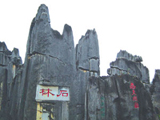 The
capital of Yunnan Province Kunming enjoys great fame among
tourists not only because the region features a consistently
warm climate, but also thanks to its wonderful vistas and landscapes.
Among the most dramatic of these attractions is the Stone Forest,
known since the Ming Dynasty (1368-1644 AD) as the 'First Wonder
of the World.'
The
capital of Yunnan Province Kunming enjoys great fame among
tourists not only because the region features a consistently
warm climate, but also thanks to its wonderful vistas and landscapes.
Among the most dramatic of these attractions is the Stone Forest,
known since the Ming Dynasty (1368-1644 AD) as the 'First Wonder
of the World.'


 In the western suburbs of Kunming, lies Western Hills. The spectacular
view across Dianchi Lake from the vantage point of West
Hills is another enjoyable experience for visitors
to Kunming. They have also been given another name - 'Sleeping
Beauty Hills' for the hills when viewed together look like a
beautiful young lady laying beside Dianchi
Lake with her face upward and her hair trailing into water
where the outline of her face, chest, and legs can be clearly
imagined.
In the western suburbs of Kunming, lies Western Hills. The spectacular
view across Dianchi Lake from the vantage point of West
Hills is another enjoyable experience for visitors
to Kunming. They have also been given another name - 'Sleeping
Beauty Hills' for the hills when viewed together look like a
beautiful young lady laying beside Dianchi
Lake with her face upward and her hair trailing into water
where the outline of her face, chest, and legs can be clearly
imagined.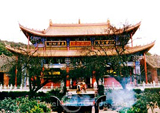 On the beautiful wooded Yu'an Mountain, only twelve kilometers
(seven miles) northwest of Kunming, is the famous Buddhist Bamboo
(Qiongzhu) Temple. The famous Buddhist Qiongzhu
Temple with its most outstanding artistic features
and surrounding bamboo forest should be visited too.
On the beautiful wooded Yu'an Mountain, only twelve kilometers
(seven miles) northwest of Kunming, is the famous Buddhist Bamboo
(Qiongzhu) Temple. The famous Buddhist Qiongzhu
Temple with its most outstanding artistic features
and surrounding bamboo forest should be visited too.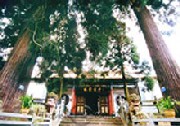 Throughout the temple are numerous inscriptions and couplets
on columns and tablets. These inscriptions date back to the 1200's
and give us glimpses into the life and culture of those times.
Other notable features of the Qiongzhu Temple include: the statues
of Four Guardian Kings in the entrance hall; the three large
statues of Buddha in the main temple building; and two majestic
450-year-old cypress trees that stand in the forecourt. Walking
around the grounds and through the bamboo forest, the world and
its problems fade away and the gentle beauty of life re-emerges.
Throughout the temple are numerous inscriptions and couplets
on columns and tablets. These inscriptions date back to the 1200's
and give us glimpses into the life and culture of those times.
Other notable features of the Qiongzhu Temple include: the statues
of Four Guardian Kings in the entrance hall; the three large
statues of Buddha in the main temple building; and two majestic
450-year-old cypress trees that stand in the forecourt. Walking
around the grounds and through the bamboo forest, the world and
its problems fade away and the gentle beauty of life re-emerges. Golden
Temple is the largest copper temple in China.
It's something of the origins of Taoism as the temple is
located on Fengming Hill, the home of the Taoist Taihe Palace
(Hall of Supreme Harmony). Located on top of Mingfeng (Singing
Phoenix) Hill is the home of the Taoist Taihe Palace (Hall
of Supreme Harmony), It is also known as the Tongwa Temple
(Bronze Tile Temple) also know by its popular name, the Golden
Temple.
Golden
Temple is the largest copper temple in China.
It's something of the origins of Taoism as the temple is
located on Fengming Hill, the home of the Taoist Taihe Palace
(Hall of Supreme Harmony). Located on top of Mingfeng (Singing
Phoenix) Hill is the home of the Taoist Taihe Palace (Hall
of Supreme Harmony), It is also known as the Tongwa Temple
(Bronze Tile Temple) also know by its popular name, the Golden
Temple. Emperor Guangxu ordered its complete repair and in 1890, using 250 tons (246 gross
ton) of solid bronze, the entire temple was again rebuilt. Except
for the staircases and balustrades, which are made of marble,
the walls, columns, rafters, roof tiles, altars, Buddha statues,
wall decorations and the banner near the gate tower are all made
of copper. The burnished copper gleamed like gold and that is
why people named it the Golden Temple. Since its last renovation,
this beloved copper temple on the top of Mingfeng Hill has been
well cared and has become the most famous Taoist shrine in Yunnan
Province.
Emperor Guangxu ordered its complete repair and in 1890, using 250 tons (246 gross
ton) of solid bronze, the entire temple was again rebuilt. Except
for the staircases and balustrades, which are made of marble,
the walls, columns, rafters, roof tiles, altars, Buddha statues,
wall decorations and the banner near the gate tower are all made
of copper. The burnished copper gleamed like gold and that is
why people named it the Golden Temple. Since its last renovation,
this beloved copper temple on the top of Mingfeng Hill has been
well cared and has become the most famous Taoist shrine in Yunnan
Province.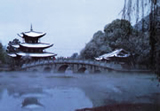 At
the foot of Longquan Hill, about 17 kilometers (10 miles) north
of the center of Kunming, there is a beautiful place called the
Black Dragon Pool (Heilongtan), also known as the Dragon Fountain
Temple (Longquanguan).
At
the foot of Longquan Hill, about 17 kilometers (10 miles) north
of the center of Kunming, there is a beautiful place called the
Black Dragon Pool (Heilongtan), also known as the Dragon Fountain
Temple (Longquanguan).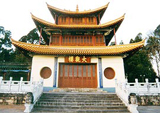 Daguan, which means 'the grand view', is the most befitting name
for the park and the pavilion which are on the terminus of Daguan
Road in the southwest of Kunming city. Daguan Park is
famous for the longest couplets in China on the Daguan Pavilion.
The Daguan Pavilion was built in the year 1828. It commands a
lovely view with rock gardens, pavilions, bridges and murmuring
water. The couplet written in the Qing Dynasty (1644-1911), contains
180 characters brimming with literary grace. During festival evenings,
gatherings take place here.
Daguan, which means 'the grand view', is the most befitting name
for the park and the pavilion which are on the terminus of Daguan
Road in the southwest of Kunming city. Daguan Park is
famous for the longest couplets in China on the Daguan Pavilion.
The Daguan Pavilion was built in the year 1828. It commands a
lovely view with rock gardens, pavilions, bridges and murmuring
water. The couplet written in the Qing Dynasty (1644-1911), contains
180 characters brimming with literary grace. During festival evenings,
gatherings take place here.